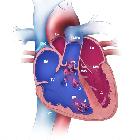Embryopathia rubeolosa



Congenital rubella syndrome is a spectrum of congenital abnormalities that result from primary maternal infection with the rubella virus. It falls under the TORCH group of infections.
It is important to note that reinfection/reactivation of maternal infection has a significantly lower risk of fetal anomalies than compared to primary infection.
Rarely congenital rubella syndrome can result in progressive diseases known as progressive rubella panencephalitis .
Clinical features
Features can include:
- congenital sensorineural deafness
- congenital cataract formation
- congenital cardiac anomalies: particularly
- intellectual/learning disabilities
- microcephaly
- intra-uterine growth restriction (IUGR)
The first three were classically termed the Gregg syndrome.
Pathology
The rate of congenital infection is worst during the 1 trimester (particularly during the first 6 weeks).
Serological markers
- maternal rubella specific IgG
- maternal rubella specific IgM
False positive results of IgM antibodies are common. It must be followed with IgG avidity testing to ensure if the infection is recent or not .
Radiographic features
Antenatal ultrasound
Sonographic findings are often not specific and a normal scan cannot absolutely exclude an infection. Features that may be seen include
- evidence of hydrops fetalis if severe
- evidence of a congenital cardiac anomaly (e.g. ASD and VSD)
- evidence of intra-uterine growth restriction
- sub-ependymal cysts: on cranial ultrasound
CT
Brain manifestations :
- small head circumference/microcephaly
- periventricular calcifications
- white matter hypodensity
- ventriculomegaly
Siehe auch:
- Hydrops fetalis
- Herzfehler
- Fallot'sche Tetralogie
- Mikrozephalie
- Intrauterine Wachstumsretardierung
- TORCH
- Ventrikelseptumdefekt
- Röteln
- progressive rubella panencephalitis
und weiter:

 Assoziationen und Differentialdiagnosen zu Embryopathia rubeolosa:
Assoziationen und Differentialdiagnosen zu Embryopathia rubeolosa:



